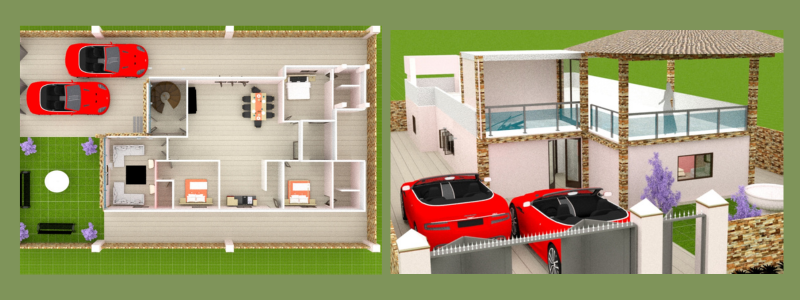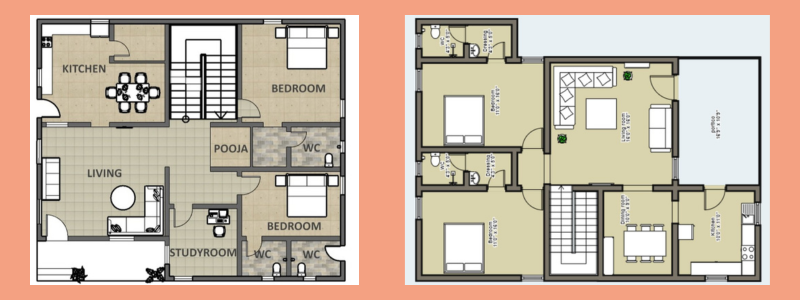You might have heard about all the hype about 3D interior design services in the real estate industry. However, it’s not just a fleeting trend. 3D interior design has become an integral tool that helps companies beat their competition and wow their clients. A reliable 3D interior design rendering service uses space planning for its floor plans. If your competitors are already taking advantage of 3D floor planning, the last thing you want is to stay caught up. Continue reading below to learn how 3D interior design rendering services use space planning for floor plans:
Space planning in interior design
Space planning is a process that involves the identification of the basic layout, purpose, and functional requirements of specific areas in houses or commercial buildings. The interior design process will only be complete with it. Instead of allowing personal tastes and stylistic preferences to dictate an interior layout, space planning requires an interior designer to consider other design elements. These considerations include at least one of the following:
RELATED: How to use SketchUp for interior design modeling
Future room usage
This element requires raising crucial questions about the different types of activities that will take place in the room, the features that will best accommodate these needs, and the effect of these needs on the space design and layout.
Circulation patterns and foot traffic
Understanding and mapping the location of the natural flow of foot traffic must affect elements such as door position, furniture choices, wall placements, and other critical decisions in interior design. There might also be some safety considerations regarding access required depending on the private client’s personal preferences or industry regulations for commercial buildings.
Multifunctional space requirements
Every area inside a house or building might only have a primary purpose. However, there could be a few requirements that should be considered for this purpose to be realized. For example, a music room requires seating, a storage area for smaller instruments, and space for bigger instruments. Identifying the primary purpose of a room will result in another series of essential questions on how to accommodate basic functionalities and achieve a good design.
RELATED: 3D interior design costs, modeling pricing, and rendering rates for buildings
Categories of different types of spaces
Generally, four categories of spaces are found in a house or building: private, social, storage, and work. These different categories affect the area’s design, furniture placement, and layout.
Importance of space planning for effective interior design
Without sufficient space planning, houses, buildings, and projects will never have a cohesive sense of function and form that makes them usable and attractive. Over-decorating functional space is prevalent, which can happen if a architectural drafting designer does not use proper space planning. These errors can be more subtle or more pronounced. However, it can still reduce the joy and satisfaction of the client in the space little by little since it no longer suits their needs or makes it harder for them to go about with their routine activities.
Although space planning addresses somewhat obvious issues, overlooking this critical stage of the planning process is a simple misstep with unpleasant consequences. Space planning helps 3D interior design services make and explain their decisions to their clients that would have been otherwise intuitive. These decisions can include furniture orientation and selection; lighting fixtures, brightness, and placement; and choice of materials. If intentional and careful space planning informed these decisions, you’d be more confident that the finished project will meet the client’s needs today and in the future.
RELATED: Differences between interior design and interior architecture companies

What’s involved in the space planning process?
Generally speaking, space planning is a process of gradually working to specific decisions from general principles while considering the preferences and needs of the client as well as the principles of sustainable and effective 3D interior design. 2D and floor plan designers first develop a rough floor map, especially if they prepare a new space or building floor plan. This floor map designates conceptual uses for the different zones, and the conceptual uses are based on the four types of spaces mentioned above.
From conceptual, 3D interior designers will then make several floor plan decisions regarding the design aspect, square footage, layout, and the like. Aside from identifying the location of the social space, clients will also need to determine if they want the area to be right next to a more private section or if this will lead to a different social space, such as the dining room or kitchen. Such decisions will impact how clients will entertain their guests and the comfort level they will experience within the space.
Aside from these high-level designations, further decisions can be made to show how the rooms break into their specific functions. The client might also require storage, seating for clients, a desk, and more. After further refining the requirements, subconscious and conscious alike, 3D interior design services can start making more specific decisions on how to meet these requirements. If storage is required, the 3D architectural rendering experts can provide specific recommendations for its appearance.
RELATED: 3D Interior rendering services for interior design firms how to make your company stand out
The process that involves three steps, from the conceptual up to the specific, can help the designers understand the exact things that the clients are searching for without requiring them to commit to a single design from the beginning.
Space planning principles
Aside from the three steps stated above, 3D interior design services also follow and adhere to several fundamental principles that serve as their guide during the space planning phase of 3D floor planning:
1. Designers consider more than one room at a time during the space planning stage
The relationship between several rooms is often partially decided for the clients because of their connection or proximity to the rest of the rooms with access to a different room or a particular purpose. The designer, for example, won’t likely turn a room next to the kitchen into a library, mainly if there is a direct connection between the two rooms. Instead, it will be more natural if the area is used as the dining room.
RELATED: 3D Interior design and rendering tips companies and firms use for bedrooms
2. Layered lighting
A 3D interior designer can use layered lighting to designate multiple uses to rooms and easily tweak the appeal in the room with a mere roll of the dimmer knob or a flick of a switch.
3. Designers will also apply the prospect and refuge theory
This is where spaces are considered to have two unique functions, which can be limited or augmented depending on the available space and the client’s preferences. Refuge areas are meant for retreat and rest, while prospective rooms look outside or into other areas. A space may also sometimes include these two functions.
4. The design is also expected to be human
This means it should include more than architectural decisions or exciting decorations. At the same time, it should also meet psychological needs and promote better physical and mental health.
5. 3D interior design services will also take note of everything before they start planning
This will make it easier and faster for them instead of trying to go back much later and moving things around to accommodate a vital request forgotten or overlooked earlier. They will catalog the demands of their clients and their personal decisions together to serve as their reference when necessary.
RELATED: How do interior design companies use 3D printed solutions inside architectural space?

Space planning and 3D floor plans
3D floor plan services use advanced and state-of-the-art technology to bring interiors to life right in front of all stakeholders involved, even if they can’t see it personally just yet. 3D floor plans add a unique layer of detail to help prospective buyers gain insight into what they can expect to get. With 3D floor plans, interior designers can get a vision of an image that resembles the real-life appearance of the design. If you’ve spent years in the industry, you might have noticed how impossible it is to envision some floor plans. Just imagine how clients feel whenever they try to visualize a blueprint.
This 2D information will be useless for those needing more industry knowledge but with 3D floor plans, professional knowledge is optional to see things which look almost real. 3D interior design services have experienced artists who work in 3D to design digital models. They will then use the finished product’s dimensions to ensure the accuracy and proportion of their model. Clients want to ensure they get the best value for their money. Providing 3D floor plans before spending anything will give them an idea of what they will get. It eliminates dissatisfaction and problems down the road.
How Cad Crowd can help
Cad Crowd is a platform where you can find professional 3D interior design services that use space planning for floor plans to ensure seamless and smooth-flowing interior spaces. Contact us today for a free quote to explore how our expertise can benefit your project needs.
